The whole enchilada
A humble-sized facility loaded with extras, Atascocita Animal Hospital in Humble, Texas, is the 2007 Veterinary Economics Hospital of the Year.
As DR. Warren Resell's staff and the co-owners of the Atascocita Animal Hospital in Humble, Texas, read this article, they're learning for the first time that they won the Hospital of the Year award in the 2007 Veterinary Economics Hospital Design Competition. Dr. Resell announced to his team that they were finalists in the competition, but he didn't spill the beans about the Hospital of the Year award. He has kept that a secret since our editorial team and his architect delivered the good news to him in December. (Note to Dr. Resell's team: Here's your cue to celebrate.)
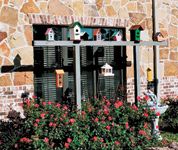
Elements of a winning facility: Birdhouses and bird feeders strategically placed outside of the cat playroom help keep the felines entertained.
Back in December, architect Ralph Thibodeau was the first to share the news with Dr. Resell. "Ralph called me and said, 'Warren, are you sitting down? We did it! We won Hospital of the Year—the whole enchilada!'" Dr. Resell recalls. "That recognition exceeded our hopes and expectations."
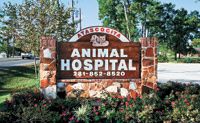
The facility's signage is made of brick and sandstone to match the building and features carved and wire-brushed redwood with laser-cut animal figures.

The garden and waterfall: A soothing sight greets clients as they pull up to the hospital. The landscaping qualifies for the Texas Parks and Wildlife and the National Wildlife Federation's backyard habitat certification programs.
Traffic patterns
So what did it for the competition's judges? The near-perfect floor plan, the striking regional architectural elements, and the colorful cat playroom all drew their attention.
One of Dr. Resell's top design priorities was a floor plan that flowed smoothly. The result: easy access from exam rooms into the treatment area. The area behind the exam rooms and the lab and pharmacy is wide enough for two technicians each carrying a patient to pass each other, and two veterinarians can work side by side without getting in each other's way. "The open layout and natural light from the clerestory windows really help set a pleasant tone for the workday," says Dr. Resell.

The waiting area: The flooring is made of porcelain ceramic tile and base tile with epoxy grout. The bench seating doubles as hidden storage space, and the flat-screen monitor is used for client education and on Saturday mornings shows cartoons.
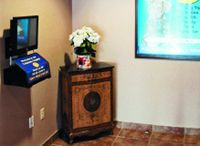
Pet information center: In an area just off the waiting room, clients can take a video tour of the hospital using a touchscreen computer that's mounted to the wall. Kids can play games on the computer or print out coloring pages. The system also answers pet-related questions and provides information about dog breeds.
Dr. Resell knew from the get-go that he didn't want any physical separation between the front and back areas of the hospital. "A lot of floor plans feature a reception area and then a brigade of exam rooms," he says. "I think that approach produces a physical and psychological separation. Instead, we designed our floor plan so there'd be a central area where the receptionists, technicians, office managers, and doctors could all meet and interact."
This open, pleasant tone carries throughout the facility and is reinforced by the inclusion of numerous windows. "Our architect designed two cupolas to flood the reception and treatment areas with natural light," Dr. Resell says. "And interior windows make it easy to see between rooms."
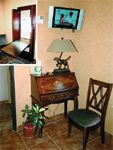
Consultation room: With a fold-down table and a radiography viewbox that are hidden by custom oak cabinets stained to match the woodwork throughout the practice (inset), the consultation room doubles as a fifth exam room or a comfort room. It's designed to have a comfortable, non-clinical feel. Upholstered chairs and an old-fashioned desk complete the homey look.
No place like home
To reflect his practice's philosophy of providing high-quality medicine in a caring family environment, Dr. Resell wanted to build a high-tech hospital with a homey feel. That comfortable feeling is evident upon driving up to the practice, located just off a busy road. Visitors are immediately granted a view of lush landscaping, a waterfall, and a pond.
The landscape design includes plants that attract birds, butterflies, and hummingbirds. A hospital team member planted the butterfly garden along the western side of the facility, and the team has counted up to 25 monarch butterflies fluttering among the flowers at once. The garden also holds the interest of the cats boarded at the facility, whose condos look out on the five-star view.
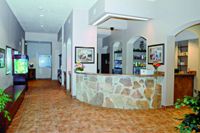
Reception: From the reception area, clients can see into the pet information center and observe fish in the 105-gallon saltwater tank. The curved reception desk, stonework, and curved archways reflect the exterior architectural elements and give the interior a touch of regional vernacular elements.
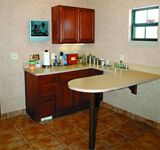
Exam: The entire facility, including exam rooms, features a central vacuum system with floor-level kickplates to make sweeping the floors a breeze. The custom red oak millwork features storage compartments of various sizes, something that Dr. Resell says he couldn't have too much of. The window floods the space with natural light.
Once clients enter the practice, they're greeted with soft music and custom artwork hanging on the walls that portrays images of pets and families. "Our clients have commented that our hospital feels like home," Dr. Resell says. "That's validation that we achieved our goal." To help balance out the soothing atmosphere with a bit of a technological edge, Dr. Resell included flat-screen monitors in every exam, consultation, and waiting room. On Saturday mornings the monitor in the waiting area shows cartoons. "So although the facility's inviting, the technology conveys the impression of a high-tech practice," he says. "We often hear clients say that our hospital is nicer than their own human hospital."
And it was built to be sturdy, too. In fact, Atascocita Animal Hospital withstood Hurricane Rita just a month before the team moved in. "I was standing with the contractor Ken Austin looking at all the massive wood beams that support the structure, and the contractor commented that if there was ever a hurricane, we should come here for shelter," Dr. Resell says. And one of his partners ended up doing just that. The facility suffered only minor damage: a lost shingle and a damaged gate latch.

Takeaway lesson
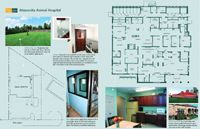
Floor plan: Atascocita Animal Hospital
In addition to being a strong facility that's client- and pet-friendly, the new practice has much better visibility than the old one, Dr. Resell says. It's a building that makes area residents take notice—even the ones that don't have pets. "I've heard people say, 'Oh yes, I know that building with the nice stone,'" he says. The practice's bottom line has also seen the effect of so much attention. The team's caseload increased 36 percent in the first year at the new facility.

Drumroll, please
Cats just wanna have fun
Dr. Resell says one of his favorite parts of the hospital is the bright, colorful cat playroom. The cats can be let out of the condos one at a time or in families to explore the room and climb on the play unit. Each condo was designed with extra space: two separate compartments and a loft. The condos also have plexiglass backing so the cats can look outside at birdhouses, a birdbath, and the butterfly garden.
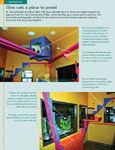
Get this look
And if the cats weren't already drooling, the large saltwater aquarium is sure to put them over the edge. It's located in the reception area and visible to visiting cats through a window in the front of the playroom. "We designed it to be a fun place for cats," Dr. Resell says, "and these details communicate to our clients that we truly love cats."
Another subtle high-tech element: fingerprint-activated locks on the cat room door so that access is limited to staff members only. This technology helps keep wandering clients—and kids—from disturbing the cats. (For more about the cat playroom see "Get this Look".)
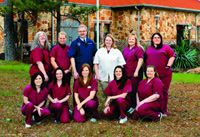
The team: (Top left) Nara McShan, Kitty Bramlet, Dr. Warren Resell, Dr. Bridget Neal, Kellie Palavanchi, Cassie England. (Bottom left) Crystal Dousay, Beth Burgess, Kristen Oliver, Tonya Tristan, Jamie Chambers. (Not pictured) Kim Cox, Francis Garcia.

A look at the numbers
Of course, the team didn't want dogs getting jealous. So the spacious canine boarding area is also flooded with natural light. Each run has its own window, and the team pipes soothing music into both the dog and cat boarding areas. To help the dogs relax even more, soundboard in the walls and acoustic tiles in the ceiling soften noise. Behind the facility, dogs have the run of the oversized exercise yard.

Treatment area: Dr. Resell's favorite area of the hospital, the large, open, spacious treatment area contains three flow tables, three dry tables, and a lift scale. It also includes an ICU with separate ventilation and oxygen delivery to each ICU cage. The ICU is located behind floor-to-ceiling glass windows with a sliding glass door so the team can easily monitor patients from the treatment area. This solution gives patients a quiet and comfortable stay in the ICU. The team can also remotely monitor patients in the ICU with mounted cameras accessible from any computer in the hospital.
Getting off the ground
Dr. Resell's biggest challenge as part of a six-partner, five-facility group practice was to build consensus among the owners before getting started—not something that happens overnight. But once everybody was onboard, Dr. Resell says the group let him take the lead, for which he's grateful. "When you have a lot of people involved, things always seem to take longer and become more complicated than you anticipated," he says. The bottom line for him was patience. "I was very concerned with getting all the details right and not allowing something to be built just for the sake of getting the job done quickly," he says.
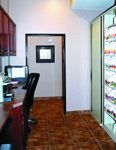
File return: The rotary files allow receptionists, doctors, technicians, and office managers to easily access patient files. The pass-through into the treatment area allows receptionists to pick up medications and records so they can discharge patients without entering the treatment room or leaving the reception area. Dr. Resell says this area is the heart of the hospital.
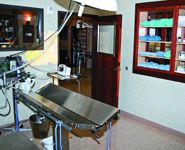
Surgery: The surgery room in Dr. Resell's previous facility was very small and contained no windows. So in his new facility, he was sure to include windows to flood the space with natural light. The room features a heated hydraulic surgery table and a glassed-in pass-through cabinet from adjacent pack prep.
The group easily overcame the hurdle of choosing an architect. Dr. Resell wanted to use a veterinary architect, but the group wanted to use a local architect, not necessarily someone who specialized in veterinary design. The compromise: a veterinary architect located in Texas.
"I saw Ralph's work in other hospitals and in Veterinary Economics," Dr. Resell says. "So I interviewed him, liked him, and found we had similar tastes. I visited every veterinary hospital he had ever built and liked all of them." The rest is history. The two got along so well that the clinic cat, Thibodeau, was named after the architect.
Dr. Resell agrees with the adage that good things come in small packages. "You don't have to spend $5 million and build a 10,000-square-foot facility to be successful," says Dr. Resell. "It takes a lot of planning and effort, but you can pack everything you need into whatever space you have available. My staff is happy, and I'm happy to come to work. It seems like everything is right."

Your chance to win